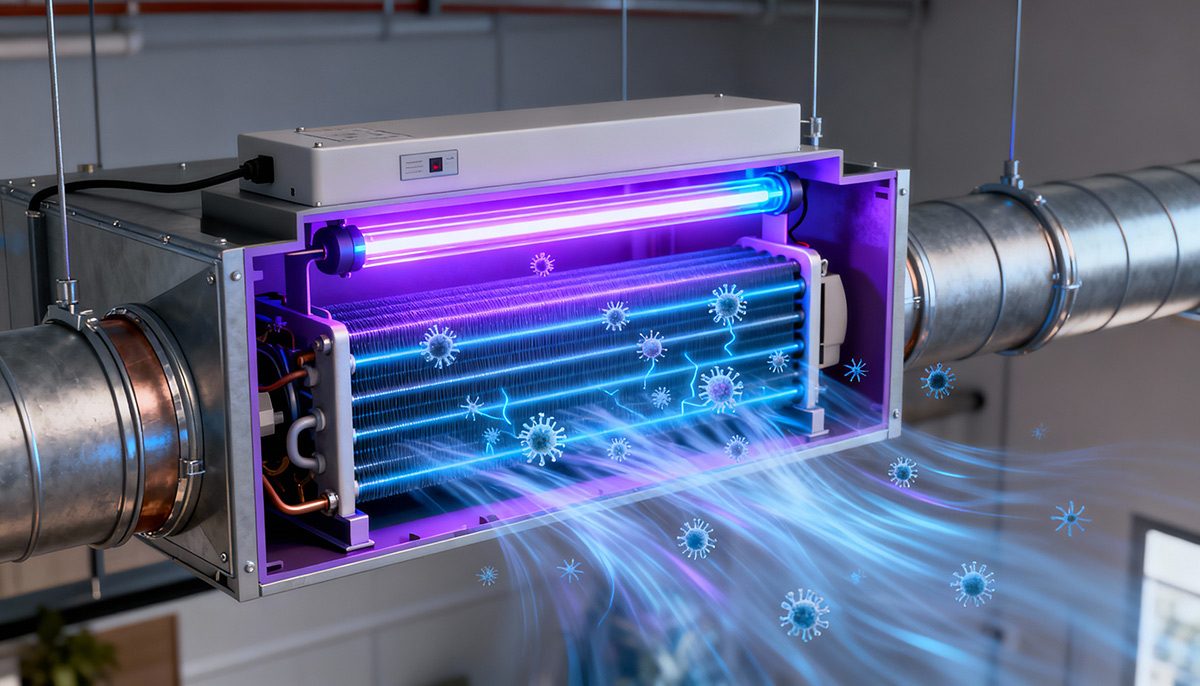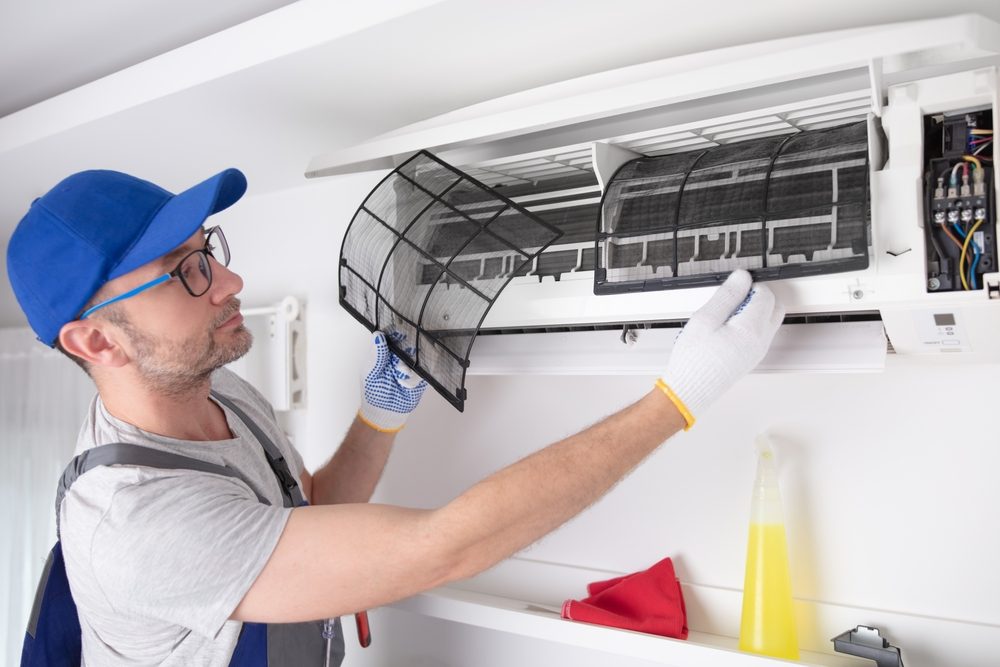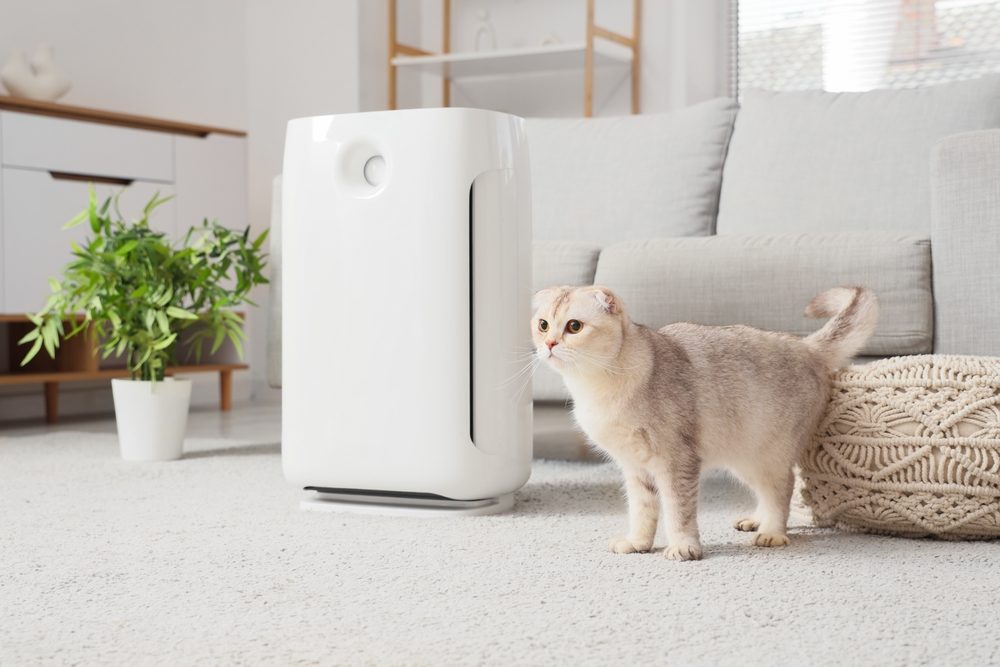
UV air purifiers are popular due to their ability to kill airborne mold spores and other pathogens, but how exactly do they work? And just how effective are they on their own? In this article, we will explore the science behind UV-C technology, examine its strengths and limitations, and explain how to use UV air purifiers safely and efficiently. You’ll also find practical guidance on installation, maintenance, and how to combine UV purification with other mold prevention methods for optimal indoor air quality. So let’s get started.
Does UV air purifier kill mold?
The short answer is yes, UV light can kill mold. It is able to kill mold by breaking down the DNA of its spores, preventing them from reproducing. This is why UV-C technology is often utilized inside of HVAC equipment, where it can kill (or at least inhibit) mold on the coils and in the ducts.
Unlike other traditional mold treatments, which use toxic chemicals, UV-C light provides a non-toxic alternative. It also is safer for its occupants and better for the planet. In addition to treating the existing mold, UV-C systems can also help to stop it from returning. For moisture-prone climates where mold is more likely to grow, the UV systems installed in HVAC systems are capable of providing protection by inhibiting the growth of spores long before they gain a foothold.
How do UV air purifiers work?
The process breaks down broadly as follows: In UV air purifiers, air enters the system before going through a HEPA filter. Then it passes through a small inner chamber, where it’s treated to a quick UV-C exposure. The key is the length of time. UV-C light needs to be ‘line of sight’ with the target and to be in direct contact with a surface for a period of time to be effective. This makes it problematic as a stand-alone approach for air cleansing, particularly in systems with fast airflow.
Which is why in most machines the first stage of defence is a HEPA filter which is efficient at trapping airborne contaminants. UV-C light can then serve as a back-up or a follow-up and support to mechanical filtration. UV-C light is hazardous to the eyes, and so the purifier ensures to keep the light sealed inside.
Limitations of UV air purifiers for mold control
UV air purifiers can, as noted above, be useful in controlling airborne mold spores, but they do have certain limitations. The reason boils down to the fact that air purifiers are designed to cut back on the amount of microscopic particles in the air rather than combat a mold issue that’s already taken hold on surfaces.
While airborne spores can be killed by UV light, the air purifier can’t remove visible mold or eliminate mold that’s already growing on walls, ceilings or furniture. If surfaces have already developed mold, manual cleaning is needed with anti-mold products.
Further the efficacy of UV light is depending on the exposure time and distance. The efficiency of UV light sterilisation is directly proportional to the time air is in contact with it, and because air in an air purifier is sucked in and out quickly it may not kill 100% of pathogens passing through it. It is for this reason that UV must be considered a secondary tool.
Best practices for using UV air purifiers
To realize the greatest advantage of UV air purifiers – particularly when aiming at mold spores – you must use them as part of a comprehensive indoor air quality strategy. While it can be successful in removing airborne contaminants, UV-C technology is not the silver bullet for ensuring unprotected individuals remain virus-free.
Installation: If you’re operating a portable unit, put it in an area with good airflow and few obstacles. Position the unit near sources of possible mold exposure: damp rooms, bathrooms, basements, but don’t block airflow against walls or in corners. Whole house systems that are built in to the HVAC units should always be installed by an expert. The UV-C lights need to be placed properly to most effectively target damp areas where mold is most likely to grow, usually near evaporator coils or inside the ductwork. If they aren’t positioned right, they may lose efficiency.
Additional techniques: The UV air purifiers only work well in conjunction with other types of mold control. Only UV light will likely not be sufficient to prevent mold when there is a persistent moisture issue in an environment. It is important to address the underlying causes of mold, which include leakages, insufficient ventilation and excessive humidity. Employ a dehumidifier, and aim to keep indoor humidity under 60. Keep bathrooms, kitchens, and laundry areas well-ventilated, and fix water problems fast. HEPA filters, which trap mold spores and other allergens as the air flows through, can also be used in conjunction with UVC light to improve the overall level of air purification.
Maintenance: Like all filters, regular maintenance is required to keep UV air purifiers working safely and optimally. UV-C bulbs degrade over time and should be changed according to the manufacturer’s recommendations – that’s generally every 9 - 12 months, even if they still seem to be working. A dimmer bulb cannot produce sufficient UV-C light to disrupt microbial DNA effectively. If your purifier has them, its filters (whether they be HEPA, carbon filters, or otherwise) must be cleaned or replaced on a regular basis. Dirty filters choke the air flow and that can lead to a decrease in your system’s performance. Monitor any warning signs or timers on your unit, and you may also want to consider air quality monitors in order to calculate the purifier’s effect on your indoor climate. This information can also help you make decisions about whether additional action is necessary.
Safety: As the UV-C light that is sometimes used in air purifiers can be dangerous for the skin and eyes, make sure the unit is fully enclosed and designed for safe use indoors. The UV light is confined to an internal chamber in top-quality air purifiers and is not harmful to people or animals. Never open the UV chamber and always follow manufacturer safety guidelines.
Regular checks: Regularly check damp areas for any signs of mold – for example, window sills, behind furniture and under sinks.
To sum up, UV air cleaners are another tool that should be part of your indoor air quality arsenal, especially when it comes to dealing with airborne mold spores. But used well, they can help augment other strategies, including good ventilation, moisture control, HEPA filtration and regular maintenance. Correctly employed and used with preventive measures, UV purifiers can be a valuable element in making your indoor air cleaner and healthier.
About Daikin
Daikin air purifiers use advanced technology including a pre-filter, HEPA and activated carbon filtration, as well as UV-C LED light to help remove a wide range of airborne pollutants. This multi-stage system not only captures allergens but also helps reduce odors, making it easier to maintain cleaner, healthier indoor air throughout the year.
Daikin leads the industry in innovation and customer support and operates in 170 countries worldwide with millions of systems installed. We offer a wide range of HVAC systems for residential, commercial, and industrial settings. Learn more about Daikin’s HVAC products by contacting us today.



